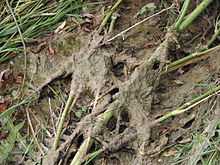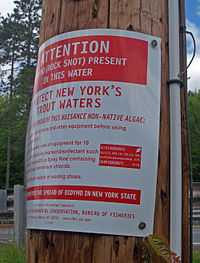Didymosphenia geminata
| Didymosphenia geminata | |
|---|---|
 | |
| Didymo found beside the Mararoa River in New Zealand. | |
| Scientific classification | |
| Domain: | Eukaryota |
| Kingdom: | Chromalveolata |
| Phylum: | Heterokontophyta |
| Class: | Bacillariophyceae |
| Order: | Cymbellales |
| Family: | Gomphonemataceae |
| Genus: | Didymosphenia |
| Species: | D. geminata |
| Binomial name | |
| Didymosphenia geminata (Lyngbye) M. Schmidt, 1899 | |
| Synonyms | |
| |
Didymosphenia geminata, commonly known as didymo or rock snot, is a species of diatom that produces nuisance growths in freshwater rivers and streams with consistently cold water temperatures and low nutrient levels.[1] It is native to the northern hemisphere, and considered an invasive species in Australia, New Zealand,[2] and Chile.[3] Even within its native range, it has taken on invasive characteristics since the 1980s.[1] It is not considered a significant human health risk,[4] but it can affect stream habitats and sources of food for fish and make recreational activities unpleasant. This microscopic alga can be spread in a single drop of water.[1]
Description

Didymosphenia geminata is a diatom, which is a type of single-celled organism unique for their silica (SiO2) cell walls. The life history of diatoms includes both vegetative and sexual reproduction, though the sexual stage is not yet documented in this species. Although it is symmetric only along the apical axis, typical of gomphonemoid diatoms, it is a cymbelloid, which are typically symmetric along both primary axes. Cells contain a raphe, which allows them to move on surfaces, and an apical porefield, through which a mucopolysaccharide stalk is secreted.
The stalk can attach to rocks, plants, or other submerged surfaces. When the diatom cell divides, through vegetative reproduction, the stalk divides too, eventually forming a mass of branching stalks. The nuisance build-up is not the cell itself, but their massive production of extracellular stalks. Extracellular polymeric substances (EPS) that form the stalks are made primarily of polysaccharides and protein, forming complex, multi-layered structures that are resistant to degradation.[5]
Native range
The native distribution of D. geminata is the cool temperate regions of the Northern Hemisphere, including the rivers of northern forests and alpine regions of Europe, Asia and parts of North America. Until its recent discovery in New Zealand, where it was introduced, it was never previously found in the Southern Hemisphere.[6] The distribution of didymo in the last two decades appears to be gradually expanding outside its native range. Even within its native range, there have been reports of excessive growths in areas where it previously existed only in low concentrations.
Current distribution
North America
Canada

Alberta: Earliest anecdotal reports of D. geminata blooms in Alberta rivers occurred as early as the mid-1990s (e.g. the upper Bow River in Banff National Park). Reports of Didymo presence and bloom formation have been documented for most rivers in the South Saskatchewan River Basin in recent years (2005 to current).
British Columbia: D. geminata was first reported as a nuisance species in the late 1980s on Vancouver Island. Since that time, outbreaks of Didymo have been reported on the island and on the mainland.[8]
Quebec: D. geminata was first officially reported in 2006 [9] but a recent report demonstrates that it was present in the sediments back in the 70s at the least.[10]
New-Brunswick: D. geminata was first reported in 2007.
United States
Arkansas: In late spring / early summer of 2005, didymo was found directly below Bull Shoals Dam on the White River. The Arkansas Department of Environmental Quality has found a 13 mile reach of the river to be affected.[11]
California: Rock snot has been around in Northern California for quite some time, and is commonly found on the North and South Fork of the Yuba River. It can also be found in reservoirs such as Lake Shasta, Bullard's Bar Reservoir, and Scotts Flat Lake.
Connecticut: In 2011 anglers reported blooms of didymo in the West Branch of the Farmington River to the Connecticut Department of Energy and Environmental Protection.[12]
Idaho: According to the Idaho Department of Fish and Game, didymo has been identified along the South Fork of the Boise River for a number of years. Biologists cannot say for sure if it is native to the drainage, or has appeared in the last 10 to 15 years.[13]
Kentucky: Didymo was found in the Cumberland River below Wolf Creek Dam in the Crocus Creek area 2008. The State of Kentucky has banned felt-soled waders in the river to prevent spread of the organism.[14]
Maryland: In May 2008, didymo was found in the Gunpowder River in Baltimore County.[15] In December 2009, it was found in the Savage River in western Maryland.[16] In May 2012, its presence was confirmed in Big Hunting Creek in Frederick County.[17]
Missouri: There are currently no known infested streams in the state. The nearest infestation is located in the White River, just south of the Missouri-Arkansas border.[18]
New Hampshire: During the summer of 2007, didymo was discovered for the first time in New Hampshire in the Connecticut River near Pittsburg.[19]
New York: In August 2007, didymo was first discovered in New York State in a section of the Batten Kill, a Hudson River tributary, in Washington County.[20] It has also been found in Esopus Creek in the Catskills.
Pennsylvania: Didymo has been confirmed in the Delaware River.[21] In 2012, its presence was confirmed in the Youghiogheny River.[22] In 2013, PA Department of Environmental Protection put out an alert that it has now been discovered in Pine Creek, Lycoming County.[23]
South Dakota: Didymo has been present in Rapid Creek in South Dakota since at least 2005, and is blamed for a significant decline in the brown trout population there. It is also present to lesser extents in other nearby locations.[24]
Tennessee: Didymo was found in the tailwaters of the Norris, Cherokee, Wilbur and South Holston hydroelectric dams in 2005, the first U.S. finding east of the Mississippi River.[25]
Vermont: In June 2007, didymo was discovered in the Connecticut River near Bloomfield, Vermont, its first recorded discovery in the northeastern United States. The sighting was reported by a fishing guide and confirmed by Dr. Sarah Spaulding, a didymo expert from Denver, Colorado.[26]
Virginia: Didymo was identified in western Virginia in the summer of 2006 in the Smith River, the Jackson River, and the Pound River.[27]

West Virginia: In 2008, didymo was found in West Virginia in the Elk River in Webster County near Webster Springs and in Glady Fork and Gandy Creek, both in Randolph County.[28][29] The alga was found in Seneca Creek in Pendleton County in 2009.[30]
South America
Chile: In 2010, the United States Geological Survey (USGS) and a Chilean laboratory, Centro de Investigacion en Ecosistemas de la Patagonia (CIEP), confirmed the identification of the diatom D. geminata (didymo) as forming extensive blooms in Chilean rivers in Chile's Los Lagos Region (X Región de Los Lagos) in the Andes west of Esquel, a town in the Chubut Province of Argentina, with reports from the Espolon River and the Futaleufú River for a total of more than 56 river kilometers affected.[31][32][33]
New Zealand
D. geminata was discovered in New Zealand in 2004, the first time it was found in the southern hemisphere. To restrict its spread, the whole of New Zealand's South Island was declared a controlled area in December 2005. Extensive publicity was carried out to limit the spread, but it has subsequently been found in an increasing number of rivers there.
Preventing further spread


The following methods have been recommended to prevent the spread of didymo in New Zealand:
Check: Before leaving the river, remove all obvious clumps of algae and look for hidden clumps. Leave them at the site. If you find clumps later don't wash them down the drain, treat them with the approved methods below, dry them and soak them in bleach for at least 4 hours.
Clean: Soak and scrub all items for at least one minute in either hot (60 °C) water, a 2% solution of household bleach, antiseptic hand cleaner, or dishwashing detergent.
Dry: If cleaning is not practical (e.g. livestock, pets), after the item is completely dry wait an additional 48 hours before contact or use in any other waterway.
New Zealand and the U.S. states of Alaska, Maryland and Vermont have banned anglers from wearing felt-soled boots. Orvis, a leading U.S. manufacturer of fly-fishing equipment, has started selling more rubber-soled boots than felt-soled.[34]
References
- ↑ 1.0 1.1 1.2 "Didymo (Rock Snot)". Department of Primary Industries, Parks, Water and Environment. 2014-05-08. Retrieved 2014-05-09.
- ↑ "Didymo". Biosecurity New Zealand. 2012-07-27. Retrieved 2014-05-09.
- ↑ "Alto al Didymo". Servicio Nacional de Pesca y Acuicultura. Retrieved 2014-05-09.
- ↑ "FAQs related to Didymo". Biosecurity New Zealand. Retrieved 2014-05-09.
- ↑ 5.0 5.1 Spaulding, S. A.; L. Elwell (2007). "Increase in nuisance blooms and geographic expansion of the freshwater diatom Didymosphenia geminata" (PDF). United States Geological Survey. Retrieved 2014-05-09.
- ↑ Biosecurity New Zealand (August 2007). "Is didymo an exotic species?". Biosecurity New Zealand. Retrieved 2013-12-01.
- ↑ Distribution map - Confirmed presence of D. geminata in the United States and Canada. U.S. Environmental Protection Agency. Retrieved on 2007-07-16.
- ↑ Didymo, Aliens Among Us. Virtual Exhibit of the Virtual Museum of Canada
- ↑ Quebec Ministry of Sustainable Development, Environment, Wildlife and Parks
- ↑ Lavery JM, Kurek J, Rühland KM, Gillis CA, Pisaric MFJ, Smol JP (2014) Exploring the environmental context of recent Didymosphenia geminata proliferation in Gaspésie, Quebec, using paleolimnology. Canadian Journal of Fisheries and Aquatic Sciences
- ↑ An Assessment and Analysis of Benthic Macroinvertebrate Communities Associated with the Appearance of Didymosphenia geminata in the White River below Bull Shoals Dam. Arkansas Department of Environmental Quality. 2006-02-24. Retrieved on 2013-04-10.
- ↑ DEP Reports Didymo Discovered in the West Branch Farmington River. Retrieved on 2014-01-15.
- ↑ Didymo presence noted in Boise River
- ↑ Aquatic Nuisance Plant Found in Cumberland River Tailwater Below Wolf Creek Dam. Kentucky Department of Fish & Wildlife Resources. Retrieved on 2011-04-10.
- ↑ Invasive Algae Found In Maryland. Maryland Department of Natural Resources. 2008-05-08. Retrieved on 2008-09-21.
- ↑ Didymo found below Savage River Reservoir. Maryland Department of Natural Resources. 2009-12-16. Retrieved on 2011-08-16.
- ↑ Didymo Infests Third Maryland Trout Stream. Maryland Department of Natural Resources. 2012-05-07. Retrieved on 2013-04-10.
- ↑ Don't Spread Didymo. Missouri Department of Conservation. 2013. Retrieved on 2013-04-10.
- ↑ FAQs about Rock Snot in New Hampshire. New Hampshire Department of Environmental Services. Retrieved on 2008-10-13.
- ↑ NYSDEC Announces Didymo Found in Lower Section of Batten Kill. (Press release). New York State Department of Environmental Conservation. 2007-08-07. Retrieved on 2008-10-13.
- ↑ Do you know about Didymo?. Pennsylvania Boat and Fish Commission. Retrieved on 2012-05-18.
- ↑ ""Rock snot" invades Youghiogheny River.". Pittsburgh Tribune-Review. 11 June 2012. Retrieved 12 June 2012.
- ↑ State Agencies Issue Alert to Contain Invasive Species in Lycoming County. Pennsylvania Department of Environmental Protection. Retrieved on 2013-07-11.
- ↑ Game, Fish and Parks news releases for July 14, 2006 South Dakota Game, Fish and Parks. 2006-07-14. Retrieved on 2007-07-16.
- ↑ Schroeder, Owen. Invasive algae 'Didymo' found in Tennessee River. Tennessee Wildlife Resources Agency. 2005-09-01. Retrieved on 2007-07-16.
- ↑ ANR Confirms First Northeastern U.S. Infestation of "Didymo". (Press release). Vermont Agency of Natural Resources. 2007-07-06. Retrieved on 2007-07-16.
- ↑ Didymo (Invasive Freshwater Algae) in Virginia. Virginia Department of Game and Inland Fisheries. Retrieved on 2008-10-13.
- ↑ West Virginia Wildlife Resources. "Didymo (Rock Snot) Fact Sheet". West Virginia Wildlife Resources. Retrieved 6 September 2011.
- ↑ Lawrence, Chris. "Invasive Algae Found in Two More Trout Streams". Metro News. Retrieved 6 September 2011.
- ↑ "Didymo Confirmed in West Virginia Creek". The Outdoor WIre (7 May 2009). The Outdoor WIre. Retrieved 6 September 2011.
- ↑ Invasive Algae Species Discovered In Chile’s Patagonia Region. The Santiago Times. Retrieved on 2010-06-01.
- ↑ Didymo Identified in Chile.. United States Geological Survey (USGS). Retrieved on 2010-05-17.
- ↑ Se Identifica Presencia de Alga Invasora Didymo en Rio Futaleufu.. Centro de Investigacion en Ecosistemas de la Patagonia (CIEP). Retrieved on 2010-05-31.
- ↑ Barringer, Felicity (August 15, 2010). "Fly Fishers Serving as Transports for Noxious Little Invaders". The New York Times. Retrieved August 17, 2010.
External links
- AlgaeBase - taxonomic and nomenclatural information
- "Didymosphenia geminata". Integrated Taxonomic Information System. Retrieved 17 July 2007.
- CISR: Rock Snot - information on Didymosphenia geminata from the Center for Invasive Species Research
- River Mystery Solved Scientists discover how “Didymo” algae bloom in pristine waters with few nutrients. Redorbit.com
- Species Profile- Didymo (Didymosphenia geminata ), National Invasive Species Information Center, United States National Agricultural Library. Lists general information and resources for Didymo.